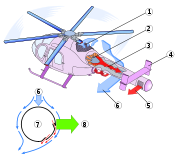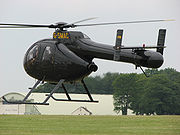
NOTAR
Encyclopedia
NOTAR is the name of a helicopter
anti-torque system which replaces the use of a tail rotor
. Developed by McDonnell Douglas Helicopter Systems
(through their acquisition of Hughes Helicopters
), the name is an acronym derived from the phrase NO TAil Rotor. The system uses a fan inside the tailboom to build a high volume of low-pressure air, which exits through two slots and creates a boundary layer
flow of air along the tailboom utilizing the Coandă effect
. The boundary layer changes the direction of airflow around the tailboom, creating thrust opposite the motion imparted to the fuselage by the torque effect of the main rotor. Directional yaw control is gained through a vented, rotating drum at the end of the tailboom, called the direct jet thruster. Advocates of NOTAR believe the system offers quieter and safer operation.
. During 1957, a Spanish prototype designed and built by Aerotecnica
flew using exhaust gases from the turbine instead of a tail rotor. This model was designated as Aerotecnica AC-14
.
Development of the NOTAR system dates back to 1975, when engineers at Hughes Helicopters
began concept development work. In December 1981, Hughes flew an OH-6A fitted with NOTAR for the first time. The OH-6A helicopter (serial number 65-12917) was supplied by the U.S. Army for Hughes to develop the NOTAR technology and was the second OH-6 built by Hughes for the U.S. Army. A more heavily modified version of the prototype demonstrator first flew in March 1986 (by which time McDonnell Douglas
had acquired Hughes Helicopters). The original prototype
last flew in June 1986 and is now at the U.S. Army Aviation Museum in Fort Rucker, Alabama. Soviet manufacturer Kamov
made a prototype on their co-axial helicopter Ka-26 which they called Ka-26SS in 1988 it never went into production.
A production model NOTAR 520N (N520NT) was later produced and first flew on May 1, 1990. It later crashed on September 27, 1994 when it collided with an AH-64D while flying as a chase aircraft for the Apache.

 Although the concept took over three years to refine, the NOTAR system is simple in theory and works to provide some directional control using the Coandă effect
Although the concept took over three years to refine, the NOTAR system is simple in theory and works to provide some directional control using the Coandă effect
. A variable pitch fan is enclosed in the aft fuselage section immediately forward of the tail boom and driven by the main rotor transmission. This fan forces low pressure air through two slots on the right side of the tailboom, causing the downwash from the main rotor to hug the tailboom, producing lift, and thus a measure of directional control. This is augmented by a direct jet thruster and vertical stabilisers.
 Benefits of the NOTAR system include increased safety (the tail rotor being vulnerable), and greatly reduced external noise. NOTAR-equipped helicopters are among the quietest certified helicopters.
Benefits of the NOTAR system include increased safety (the tail rotor being vulnerable), and greatly reduced external noise. NOTAR-equipped helicopters are among the quietest certified helicopters.
:

Helicopter
A helicopter is a type of rotorcraft in which lift and thrust are supplied by one or more engine-driven rotors. This allows the helicopter to take off and land vertically, to hover, and to fly forwards, backwards, and laterally...
anti-torque system which replaces the use of a tail rotor
Tail rotor
The tail rotor, or anti-torque rotor, is a smaller rotor mounted so that it rotates vertically or near-vertically at the end of the tail of a traditional single-rotor helicopter. The tail rotor's position and distance from the center of gravity allow it to develop thrust in the same direction as...
. Developed by McDonnell Douglas Helicopter Systems
MD Helicopters
MD Helicopters, Inc. is an aerospace company that produces helicopters primarily for commercial use. Coverage here includes the company's tenure as McDonnell Douglas Helicopter Systems, a subsidiary of McDonnell Douglas.-Background:...
(through their acquisition of Hughes Helicopters
Hughes Helicopters
Hughes Helicopters was a major manufacturer of military and civil helicopters from the 1950s to the 1980s.The company began in 1947, as a unit of Hughes Aircraft, then was part of the Hughes Tool Company after 1955. It became the Hughes Helicopter Division, Summa Corporation in 1972, and was...
), the name is an acronym derived from the phrase NO TAil Rotor. The system uses a fan inside the tailboom to build a high volume of low-pressure air, which exits through two slots and creates a boundary layer
Boundary layer
In physics and fluid mechanics, a boundary layer is that layer of fluid in the immediate vicinity of a bounding surface where effects of viscosity of the fluid are considered in detail. In the Earth's atmosphere, the planetary boundary layer is the air layer near the ground affected by diurnal...
flow of air along the tailboom utilizing the Coandă effect
Coanda effect
The Coandă effect is the tendency of a fluid jet to be attracted to a nearby surface. The principle was named after Romanian aerodynamics pioneer Henri Coandă, who was the first to recognize the practical application of the phenomenon in aircraft development....
. The boundary layer changes the direction of airflow around the tailboom, creating thrust opposite the motion imparted to the fuselage by the torque effect of the main rotor. Directional yaw control is gained through a vented, rotating drum at the end of the tailboom, called the direct jet thruster. Advocates of NOTAR believe the system offers quieter and safer operation.
Development
The use of directed air to provide anti-torque control had been tested as early as 1945 in the British Cierva W.9Cierva W.9
-References:-External links:*...
. During 1957, a Spanish prototype designed and built by Aerotecnica
Aerotécnica
Aerotécnica was a Spanish aircraft manufacturer established in Madrid in 1954 to develop Jean Cantinieau's helicopter designs. After manufacturing small numbers of the AC-12 and AC-14, the firm ceased trading in 1962.-Aircraft:* Aerotécnica AC-11...
flew using exhaust gases from the turbine instead of a tail rotor. This model was designated as Aerotecnica AC-14
Aerotécnica AC-14
The Aerotécnica AC-14 was a Spanish five-seat light helicopter of the 1950s, designed by Jean Cantinieau, based on enlarging his Nord Norelfe design....
.
Development of the NOTAR system dates back to 1975, when engineers at Hughes Helicopters
Hughes Helicopters
Hughes Helicopters was a major manufacturer of military and civil helicopters from the 1950s to the 1980s.The company began in 1947, as a unit of Hughes Aircraft, then was part of the Hughes Tool Company after 1955. It became the Hughes Helicopter Division, Summa Corporation in 1972, and was...
began concept development work. In December 1981, Hughes flew an OH-6A fitted with NOTAR for the first time. The OH-6A helicopter (serial number 65-12917) was supplied by the U.S. Army for Hughes to develop the NOTAR technology and was the second OH-6 built by Hughes for the U.S. Army. A more heavily modified version of the prototype demonstrator first flew in March 1986 (by which time McDonnell Douglas
McDonnell Douglas
McDonnell Douglas was a major American aerospace manufacturer and defense contractor, producing a number of famous commercial and military aircraft. It formed from a merger of McDonnell Aircraft and Douglas Aircraft in 1967. McDonnell Douglas was based at Lambert-St. Louis International Airport...
had acquired Hughes Helicopters). The original prototype
Prototype
A prototype is an early sample or model built to test a concept or process or to act as a thing to be replicated or learned from.The word prototype derives from the Greek πρωτότυπον , "primitive form", neutral of πρωτότυπος , "original, primitive", from πρῶτος , "first" and τύπος ,...
last flew in June 1986 and is now at the U.S. Army Aviation Museum in Fort Rucker, Alabama. Soviet manufacturer Kamov
Kamov
Kamov is a Russian rotor-winged aircraft manufacturing company that was founded by Nikolai Il'yich Kamov, who started building his first rotor-winged aircraft in 1929, together with N. K. Skrzhinskii...
made a prototype on their co-axial helicopter Ka-26 which they called Ka-26SS in 1988 it never went into production.
A production model NOTAR 520N (N520NT) was later produced and first flew on May 1, 1990. It later crashed on September 27, 1994 when it collided with an AH-64D while flying as a chase aircraft for the Apache.
Concept


Coanda effect
The Coandă effect is the tendency of a fluid jet to be attracted to a nearby surface. The principle was named after Romanian aerodynamics pioneer Henri Coandă, who was the first to recognize the practical application of the phenomenon in aircraft development....
. A variable pitch fan is enclosed in the aft fuselage section immediately forward of the tail boom and driven by the main rotor transmission. This fan forces low pressure air through two slots on the right side of the tailboom, causing the downwash from the main rotor to hug the tailboom, producing lift, and thus a measure of directional control. This is augmented by a direct jet thruster and vertical stabilisers.

Applications
There are three production helicopters that utilize the NOTAR system, all produced by MD HelicoptersMD Helicopters
MD Helicopters, Inc. is an aerospace company that produces helicopters primarily for commercial use. Coverage here includes the company's tenure as McDonnell Douglas Helicopter Systems, a subsidiary of McDonnell Douglas.-Background:...
:

- MD 520N - a NOTAR variant of the Hughes/MD500MD Helicopters MD 500The MD Helicopters MD 500 series is an American family of light utility civilian and military helicopters. The MD 500 was developed from the Hughes 500, a civilian version of the US Army's OH-6A Cayuse/Loach...
series helicopter. - MD 600NMD Helicopters MD 600|-See also:-External links:*...
- a larger version of the MD 520N. - MD ExplorerMD Helicopters MD Explorer|-See also:-References:* Jackson, Paul. Jane's All The World's Aircraft 2003–2004. Coulsdon, UK: Jane's Information Group, 2003. ISBN 0 7106 2537 5.-External links:* *...
- a twin-engine, 8-seat light helicopter.
See also
- Cierva-Weir W.9Cierva W.9-References:-External links:*...
- HelicopterHelicopterA helicopter is a type of rotorcraft in which lift and thrust are supplied by one or more engine-driven rotors. This allows the helicopter to take off and land vertically, to hover, and to fly forwards, backwards, and laterally...
- Tail rotorTail rotorThe tail rotor, or anti-torque rotor, is a smaller rotor mounted so that it rotates vertically or near-vertically at the end of the tail of a traditional single-rotor helicopter. The tail rotor's position and distance from the center of gravity allow it to develop thrust in the same direction as...
- Other alternatives to conventional tail rotor
- FenestronFenestronA Fenestron is a shrouded tail rotor of a helicopter that is essentially a ducted fan. The housing is integral with the tail skin, and, like the conventional tail rotor it replaces, is intended to counteract the torque of the main rotor...
- Tip jet rotor
- Coaxial rotors
- Tandem rotors
- Synchropter
- Fenestron
External links
- MD Helicopters
- Youngcopter, manufacturer of the neo - a kit helicopter with Wankel engineWankel engineThe Wankel engine is a type of internal combustion engine using an eccentric rotary design to convert pressure into a rotating motion instead of using reciprocating pistons. Its four-stroke cycle takes place in a space between the inside of an oval-like epitrochoid-shaped housing and a rotor that...
and NOTAR-like anti-torque system.

